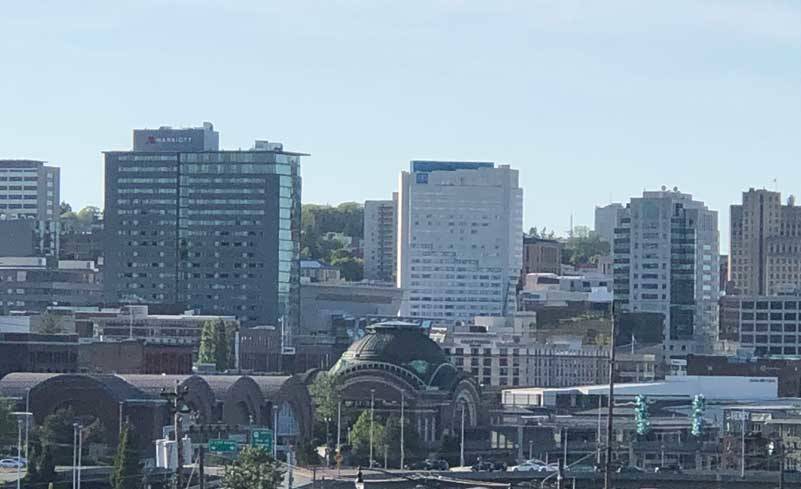By Morf Morford
Tacoma Daily Index
In the old days, like a couple years ago, when a business was bought or sold, or even just analyzed in-house, the guiding assumption was that any business had two parts; assets and liabilities.
Everything in a business, at least traditionally, was on one side of the ledger; either positive or negative – what a company owns versus what it owes.
Evaluating a business was a simple equation; assets were usually physical things, materials, resources, or property for example. Liabilities were primarily outstanding debts.
As time went on, assets, and to a degree, liabilities took on increasingly intangible forms – reputation, brand loyalty and market share began to matter more than actual (or even potential) inventory.
What is true for a business is at least as true for a community.
For better or worse, every community has its own identity – its own place in the constellation of surrounding communities.
Every metric, official or unofficial, objective or subjective, factors into how we perceive, evaluate and categorize other communities – and our own.
One entirely unscientific, but perhaps accidently revealing metric is “OfferUp”.
“OfferUp” is an app, and has a regional Puget Sound area website that allows people to post things they would like to sell or get rid of. (They are based in Bellevue, and have listings in cities across the nation.)
As with Halloween trick or treating, some neighborhoods have better offerings than others.
As you might expect, some neighborhoods have more disposable income, some are more stable, and some, like those around military bases, are inherently more transitional.
Others are closer to, or further from, speciality stores – like Pottery Barn or Ikea for example.
Other neighborhoods might have a strong ethnic presence – with a related emphasis in style, crafts or preference.
Some communities in the Greater Puget Sound area take their names and identities from their geographical features – the Sammamish Plateau and the Auburn Valley are only a couple examples.
The surrounding terrain, from mountain ranges to river watersheds, have given us ample (and, yes renewable) water and recreational resources other areas could only dream of.
Others take their identities from prevailing or historic industries from fishing to timber to assets of trade like railroads or local ports.
Boeing has certainly defined Seattle for the past many decades. Starbucks and Amazon largely define the city, if not the greater Puget Sound region.
Each of those companies act as an embassador of sorts for our corner of the world.
These, and many others, are the assets and defining features of our region.
One of our liabilities, at least from the point of view of many business and political leaders, is our relative distance, if not isolation from the rest of the country.
As with every liability though, this has served as an inspiration as much as an obstacle.
Over the years many have gone to more established areas for education or business opportunities.
A large number of these have returned to start businesses here, and because of our real or perceived isolation, these businesses have taken on a distinctive Pacific Northwest essence.
Starbucks, Boeing, Amazon and REI, among many others, show their northwest roots wherever around the world they may encounters their customers.
Our assets then, are our strengths and our liabilities are our challenges.
Both define us.
As we have seen, especially in the past year or two, no asset or liability is static.
Ideas and entrepreneurial ventures may flourish or evaporate, corporate headquarters (as in Boeing) may leave or others, like Amazon, dominate the financial (and actual) landscape that they take up all the available space for any others entrants.
What were once an asset in Seattle, for example, cheap warehouses for rent available for artists, musicians, creators and uses of all kinds from breweries to performance venues, have become unaffordable and, though many stand empty, their prices keep out many would-be occupants.
So in an unexpected turn of events, success has become a liability in Seattle.
We in Tacoma have many assets Seattle either never had or has lost in its rush for prominence.
Our relative affordability (for residential and commercial space) is an asset we can not afford to lose.
We have opportunities for co-working spaces and live/work lofts and other sites other communities would love to have.
Our outlying areas offer a range of recreational and agricultural uses (not to mention outstanding views) other regions could not begin to imagine.
Our assets make us strong, but our liabilities make us stronger.
From our weather to our landscape to our business climate, the one unrelenting constant in life is change – from volcanic upheavals to storm fronts or corporate relocations – we, some of us at least, have learned to ride out the chaos, sit out the seemingly endless drizzly winters and see that, like the turn of the seasons, what were once seen as liabilities, can under the right conditions, and in their own time, and maybe under the right kind of pressure, become assets like no one could have expected.
Tacoma is that kind of place.





